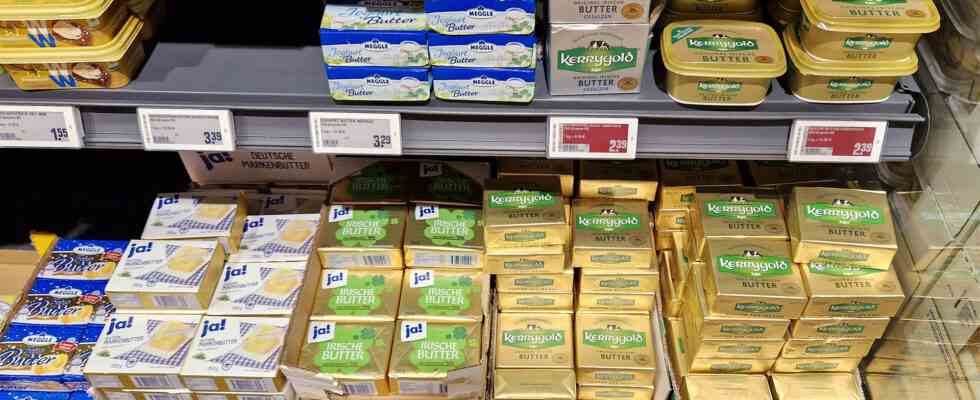Status: 02/22/2023 08:52 a.m
First the prices for butter exploded, within a few months they dropped again by 70 cents. Experts believe that food companies have screwed up prices in order to rake in profits.
This is good news for supermarket customers: butter is 70 cents cheaper than it was in September. The price of own brands has been EUR 1.59 across the board since the beginning of February. The reason: Aldi started a price war – and everyone is following suit.
This is exactly what Kolja ter Horst, co-managing director of three Edeka markets in northern Hesse, confirms. He clearly notices that customers are now taking the “dumping prices” seriously: “Some buy 10 or 15 pieces right away. I wouldn’t talk about buying hamsters or anything, but of course, based on the sales you can see that that’s very benevolent Is accepted!”
Why are mega discounts suddenly possible?
But why can Aldi suddenly lower the price so significantly? The discounter explains in a press release: “By significantly reducing the price of an everyday item, we are creating a noticeable relief for our customers.”
A relief that arrives, for example with Eva-Maria Michlenz, who has just shopped at Aldi in Vellmar in northern Hesse and is surprised at how much discount is suddenly possible. “I think they used the Corona crisis and the Ukraine war to raise prices. That made everything more expensive anyway, it was less noticeable and people didn’t go on the barricades.”
Experts amazed at the extreme fluctuation
Can this be? Have food companies actually used the crisis to maximize their profits? Nikos Förster is responsible for the areas of economy and market at the Landesbetrieb Landwirtschaft Hessen. He says that he has never experienced such an exceptional situation in the food market in his entire professional career.
In January 2022, the butter price was 1.65 euros. In September it reached its all-time high of EUR 2.29. Now suddenly the steep descent to 1.59 euros. “An incredible 70 cent price difference between September and today,” says Förster, shaking his head. From his point of view, there is only a partial rational explanation for the roller coaster ride.
Full camps and new negotiations
At the end of January, the contracts between the manufacturers of dairy products and retailers expired and had to be renegotiated. “The dairy industry had a problem: Because the price was so high last year, the farmers produced a lot.” The camps are full, explains Förster.
“The food markets took that as an opportunity to put pressure on them. They said, ok, we don’t have any shortages in the markets, so we have more scope down again in terms of prices.”
Simply put “a shovel on top”.
However, Förster does not believe that the extreme heights last year were only possible because of such negotiations. “Of course, it’s possible that the food retail trade also took this as an opportunity to up the ante a little,” he says, recalling the discussion about petrol prices, in which the gas station owners always used the increased raw material prices as an argument:
If you put that in perspective, you realize that the price increases at the petrol stations were not justified, and I don’t want to completely rule out the possibility that the same thing happened in food retail at one point or another.
Cream and yoghurt could also become cheaper
Consumers are now hoping that the falling milk prices will have a signal effect on the entire food industry. According to the Federal Statistical Office, prices increased by 7.9 percent in 2022 compared to the previous year. Market experts assume that they will not normalize again until next year and that inflation will level off at around two percent.
But at least in the dairy industry there are signs that give customers hope for further savings this year. Förster expects that cream, yoghurt and quark could follow suit.
Next item: coffee
Appropriately, Aldi has just heralded the second round in the battle for customers’ favor: the discounter has reduced the prices of its own-brand coffee by 20 percent.
Of course, following the laws of the market, the competitors immediately followed suit – and also significantly reduced.

